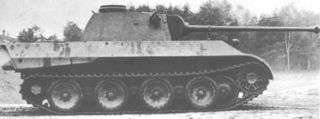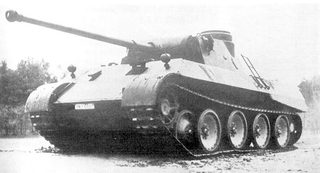VK 30.02 (M)
VK3002M (Stock)
| 915000 Cena |
| 950 HPVýdrž |
| 39.93 / 45 Hmotnost |
- Velitel
- Střelec
- Řidič
- Radista
- Nabíječ
| 60/40/40Pancíř korby(čelní/boční/zadní, mm) |
| 80/45/45Pancíř věže(čelní/boční/zadní, mm) |
| 580 hpVýkon motoru |
| 55 km/hMax. rychlost / couvání |
| 36 stupňů/sRychlost otáčení |
| 160 damage |
| 110 mmPrůměrná průbojnost |
| 7.3469387755102 Doba úplného nabití |
| 30 stupňů/sRychlost nastavení odměru |
| 240 mDohled |
| 500 mDosah rádia |



Věž
| Úroveň | Věž | Pancíř věže (čelní/boční/zadní, mm) | Rychlost nastavení odměru (stupňů/s) | Dohled (m) | Zkušenosti | Hmotnost (t) |
|---|---|---|---|---|---|---|
| V | VK 30.02 (M) | 80/45/45 | 30 | 240 | 0 | 6260 |
| Úroveň | Dělo | Průměrná průbojnost (mm) | Rychlost palby | Rozptyl na 100 m | Čas zaměření | Zkušenosti | Hmotnost (t) | |
|---|---|---|---|---|---|---|---|---|
| V | 7,5 cm Kw.K. 40 L/48 | 110/158/38 | 160/160/200 | 8.17 | 0.39 | 2.3 | 0 | 1520 |
| VI | 7,5 cm Kw.K. 42 L/70 | 150/194/20 | 160/160/200 | 8.87 | 0.35 | 2.3 | 4600 | 1740 |
| Úroveň | Věž | Pancíř věže (čelní/boční/zadní, mm) | Rychlost nastavení odměru (stupňů/s) | Dohled (m) | Zkušenosti | Hmotnost (t) |
|---|---|---|---|---|---|---|
| VI | VK 30.02 Ausf. A | 100/45/45 | 30 | 240 | 6140 | 7760 |
| Úroveň | Dělo | Průměrná průbojnost (mm) | Rychlost palby | Rozptyl na 100 m | Čas zaměření | Zkušenosti | Hmotnost (t) | |
|---|---|---|---|---|---|---|---|---|
| V | 7,5 cm Kw.K. 40 L/48 | 110/158/38 | 160/160/200 | 9.12 | 0.39 | 2.3 | 0 | 1520 |
| VI | 7,5 cm Kw.K. 42 L/70 | 150/194/20 | 160/160/200 | 9.75 | 0.35 | 2.3 | 4600 | 1740 |

Motor
| Úroveň | Motor | Výkon motoru (hp) | Pravděpodobnost požáru při zásahu | Zkušenosti | Hmotnost (t) |
|---|---|---|---|---|---|
| VI | Daimler-Benz MB 503 | 580 | 20 | 0 | 900 |
| VII | Maybach HL 210 TRM P30 | 650 | 20 | 13280 | 850 |
| VIII | Maybach HL 230 TRM P30 | 700 | 20 | 15800 | 1200 |

| Úroveň | Podvozek | Maximální nosnost | Rychlost otáčení (stupňů/s) | Zkušenosti | Hmotnost (t) |
|---|---|---|---|---|---|
| V | VK 30.02 (M) | 45 | 36 | 0 | 15000 |
| VI | VK 30.02 Ausf. A | 45 | 38 | 6490 | 15000 |

Rádio
| Úroveň | Rádio | Dosah rádia (m) | Zkušenosti | Hmotnost (t) |
|---|---|---|---|---|
| III | FuG5_GER | 500 | 0 | 50 |
Compatible Equipment
Compatible Consumables
Player Opinion
Pros and Cons
Pros:
- Very strong gun mantlet
- Accurate top gun with high DPM and good penetration values
- Large hitpoints pool
- Powerful top engine which gives good mobility to tank
Cons:
- Weak side armour
- Frontal gearbox means that hits on the lower glacis might start a fire
- Large ammorack that tends to get damaged easily
- Somewhat large profile makes finding a good hiding spot or avoiding fire harder then other mediums
Performance
This tank is a sniper and flanker hybrid. The armor while bouncy, is not thick enough to block the majority of tier VI weaponry. Brawling should be avoided when possible due to fairly low alpha damage and low armor. Hulldown is effective. The turret while not being the smallest target has a very high tendency to bounce shots at long ranges, and the L/70 will make short work of most tanks. Angling is not very effective due to the paper thin 40mm side armor, but can be used against small caliber guns to increase the chances of a bounce. Also due to the fairly large profile, one has to take extra time to make sure the bush they are sitting in (if abusing camo skill and nets) is big enough to hide the entire tank. It is also very hard to avoid enemy fire, since the tank is somewhat large for a medium (comparable to a small heavy), meaning that the only ways to take fire is in a hull down (moderately bouncy turret), or when angled properly with teh lower plate preferably hidden (assuming the gun is a low end tier V or most tier IV guns, as anything with more then 130mm of penetration will go through the tank regardless of angle unless it gets a lucky bounce)
The top gun is quite potent and capable of penetrating most tier VI and some VII tanks frontally. Alpha damage is lacking but the gun offers fairly high DPM with the top turret. Sniping is very good with this tank as the L/70 has the accuracy to hit weakspots up to a range of about 300m and has enough penetration as to allow penetrations to the front of most tanks.
Overall this tank is quite similar to the pre 8.8 VK 30.01 (H), with good maneuverability, much better hull armor, slightly worse turret armor, having access to the same guns, sans the 8.8cm KwK 36 L/56, and overall allowing the use of similar tactics. Anyone who enjoyed the VK 30.01(H) will most likely enjoy this tank. It should also be noted that this tank plays quite similarly to a historically accurate version of its child and successor, the Panther I, though the Panther historically was used more for sniping, and of course weighed more.
Still, take into consideration that the tank is designed for sniping or long range attacks. While close up flanking may be a viable tactic, it makes more sense to start out taking long range shots at exposed enemies, letting your team soak up damage.
Early Research
The top gun should already be researched from the VK 30.01(H), so mount it immediately.
The priority in this tank is to max out the engine and suspension due to it being much more mobile then the next tank in line: the Panther.
Finally get the upgraded turret for a slight boost in both armor and rate of fire.
Historical Info
The DB design resembled the T-34 in hull and turret form. DB's proposal used a leaf spring suspension, in contrast to the T-34s coil spring suspension. The leaf spring suspension lay outside of the hull. Subsequently, the hull was more narrow, offering a smaller turret ring. Thus, the DB turret was necessarily smaller than that of the MAN design. The main advantages of the leaf springs over a torsion bar suspension were lower hull silhouette and a simpler shock damping design. Like the T-34, the DB design had a rear drive sprocket and a forward situated turret, but unlike the T-34, the DB design had the preferred three-man turret crew: commander, gunner, and loader. As the planned L/70 75 mm gun was much larger than the T-34's, mounting it in the Daimler-Benz turret was difficult. Plans to address the space limitations by reducing the turret crew to two men were considered, but were eventually discarded as experience had shown this to be a less effective arrangement.
The MAN design embodied more conventional German thinking with the transmission and drive sprocket in the front and a centrally mounted turret. It had a gasoline engine and eight torsion-bar suspension axles per side. Because of the torsion bar suspension and the drive shaft running under the turret basket, the MAN Panther was higher and had a wider hull than the DB design. The Henschel firm's design concepts for their Tiger I tank's suspension/drive components, using its characteristic Schachtellaufwerk-format large, overlapping, interleaved road wheels with a "slack-track" using no return rollers for the upper run of track were repeated with the MAN design for the Panther. These large, rubber-rimmed steel wheels added to the protection of the hull from a lateral penetrating shot.
The two designs were reviewed over a period from January through March 1942. Reichminister Todt, and later, his replacement Albert Speer, both recommended the DB design to Hitler because of its several advantages over the initial MAN design. However, at the final submission, MAN improved their design, having learned from the DB proposal, and a review by a special commission appointed by Hitler in May 1942 ended up selecting the MAN design. Hitler approved this decision after reviewing it overnight. One of the principal reasons given for this decision was that the MAN design used an existing turret designed by Rheinmetall-Borsig, while the DB design would have required a brand new turret to be designed and produced, substantially delaying the commencement of production.
Historical Gallery
Sources and External Links
| Light Tanks | |
| Medium Tanks | |
| Heavy Tanks | |
| Tank Destroyers | |
| Self-Propelled Artillery |
| USA | |
| UK | |
| Germany | |
| USSR | |
| China | |
| Japan |

